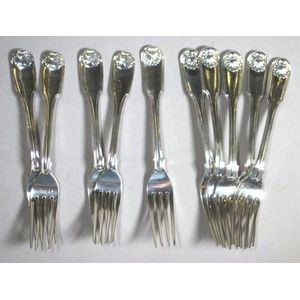Georgian and Victorian Silver Dessert Forks Set
You must be a subscriber, and be logged in to view price and dealer details.
Subscribe Now to view actual auction price for this item
When you subscribe, you have the option of setting the currency in which to display prices to $Au, $US, $NZ or Stg.
- Georgian - As an English stylistic period, Georgian is usually taken to cover the period from George I (1714) to the Regency of Prince George (1811-20), although the period from 1800 to 1830 is sometimes designated as the Regency period. During the Georgian period the great English cabinetmakers and designers such as Chippendale, Hepplewhite, Adam Sheraton etc., were all active.
Therefore there isn't a single 'Georgian style' as such and to say something is 'Georgian', usually means it was made between 1714 and 1830. This assumes we discount George V and George VI, both being from the 20th century.
The styles popular at the time of each reign were:
George I (1714-1727) saw out the last years of the Baroque period.
George II (1727-1760) reigned during the Rococo period.
George III (1760-1820) saw the last gasp of the Rococo, all of the early Neo-Classic 'Adam style' and most of the later neo-Classic 'Regency style'.
George IV (Prince Regent 1820-1830)encompassed the last of the 'Regency' style.
William IV's reign (1830-1837) was something of a no man's land (stylistically) and he wasn't a 'George' anyway. He covered the last glimmerings of 'Regency' and the start of the 'Victorian' style. - Victorian Period - The Victorian period of furniture and decorative arts design covers the reign of Queen Victoria from 1837 to 1901. There was not one dominant style of furniture in the Victorian period. Designers used and modified many historical styles such as Gothic, Tudor, Elizabethan, English Rococo, Neoclassical and others, although use of some styles, such as English Rococo and Gothic tended to dominate the furniture manufacture of the period.
The Victorian period was preceded by the Regency and William IV periods, and followed by the Edwardian period, named for Edward VII (1841 ? 1910) who was King of the United Kingdom and the British Dominions and Emperor of India for the brief period from 1901 until his death in 1910.
This item has been included into following indexes:
Visually similar items

Eight various Georgian sterling silver main forks, of various dates, in fiddle pattern, some with engraved crests to handles, total weight 590gm, (8)

Ten Georgian sterling silver dessert forks, fiddle, thread and shell pattern, London hallmarks comprising of 5@ crested spoons 1826 (William Eley II), 2@ 1820 (William Eley & William Fearn), 2@ 1819 (William Eley & William Fearn) and 1@ 1822 (Francis Higgi

Set of eleven Victorian sterling silver entree forks, hallmarked, London, 1846, George William Adams of Chauner & Co, engraved with crest and coronet for Count Montemerli Sandonini, total weight 616gm, (11)

Five Georgian Irish sterling silver fiddle pattern table forks and one London make. Dates 1826 -1833. Initialled P. Dublin hallmarks. Weight 354g
